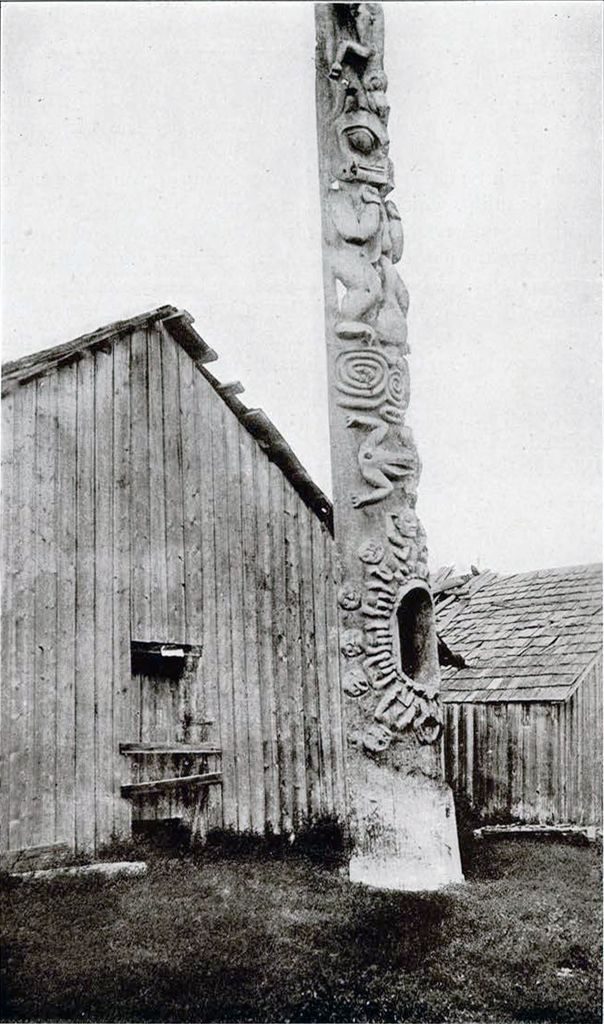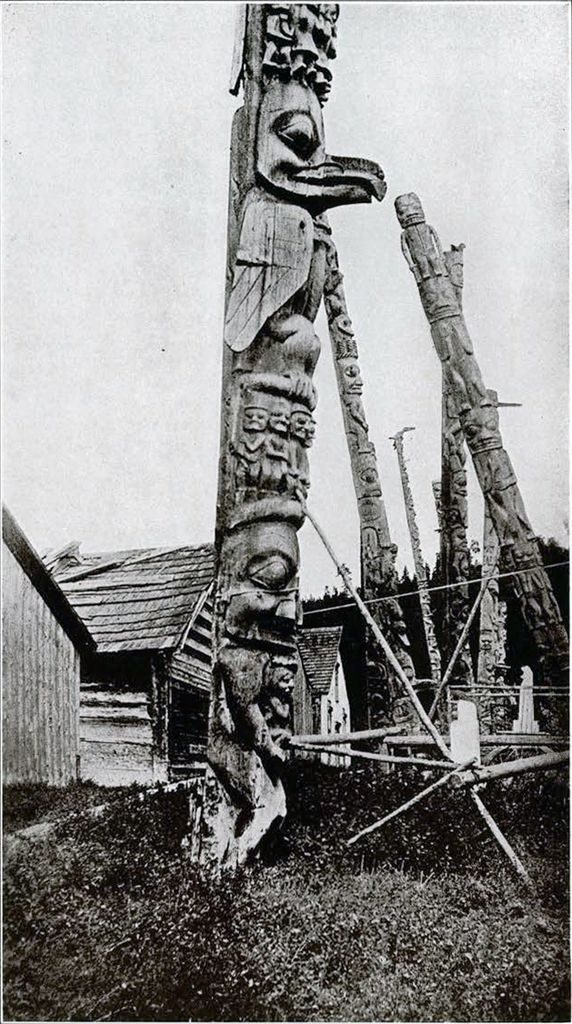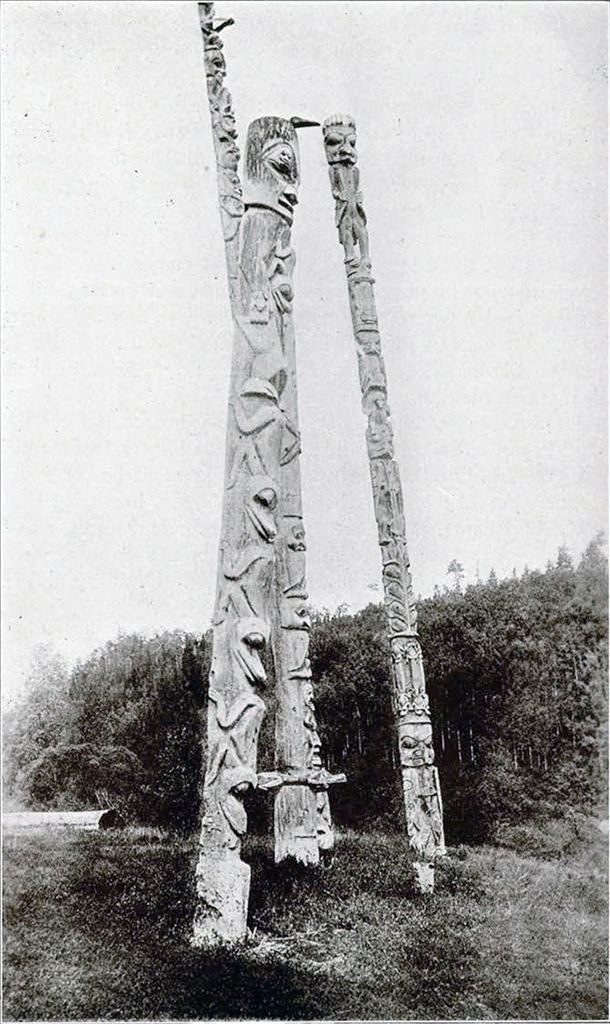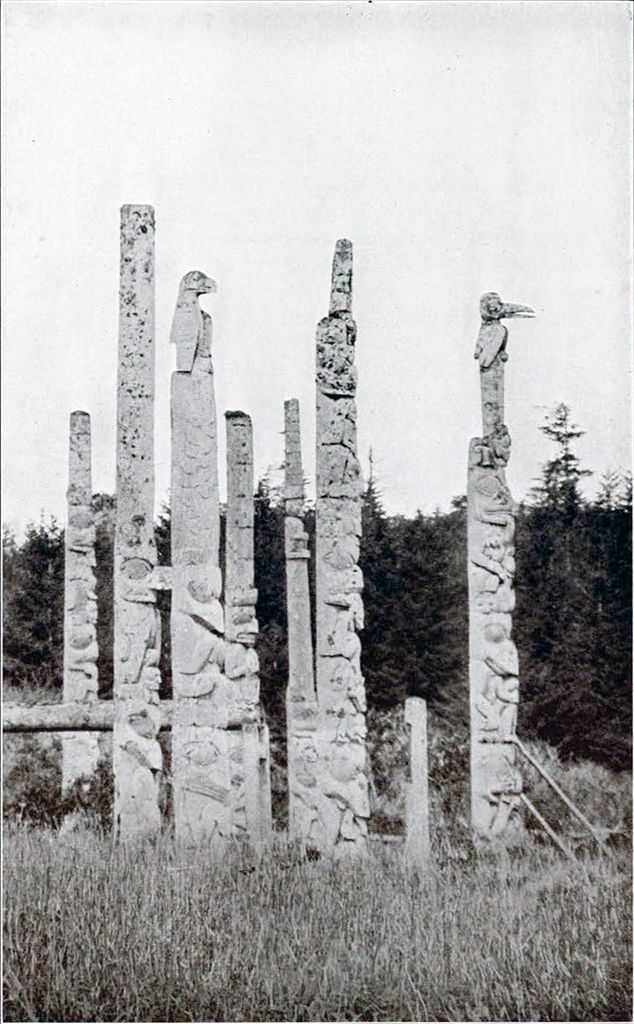These stories were told to me in the summer of 1917 by Walter Wright and I wrote them down. Walter lives on the Skeena River between Kitsamkalum and Lakelse in Northern British Columbia. He is well known and respected by the white settlers in that district. He is an industrious Indian and works night and day at his fishing and in the new logging camps or on the ranches to support his family, which includes not only a wife and children but mother-in-law and nephews and nieces to the number of twenty or more. During the short period of our acquaintance I formed a great opinion of Walter. I have tried to preserve the style of his narrative and as far as possible his own words. Clearness required rewriting, and the written story loses a great deal because it lacks the picturesque and dramatic quality which was imparted to it in the telling. It had, moreover, to be abridged owing to the shortness of the time at my disposal and on this account much matter of interest is doubtless omitted. I present it on the authority of Walter Wright, the lineal descendant of Nis-ha-was the Great Chief. I am giving now only the first part of the legends of Kit-selás. At another time I may give more of them to readers of the JOURNAL.
G. B. G.
The Migration
It happened long ago, away up the Skeena River near the place where Hazelton is now. There was a big Indian town at the foot of the high mountain; it was so big that many of the people did not know each other. One day a hunter went up into the mountain to hunt wild goats and he happened to catch a small he-goat and brought him down to the town and gave him to the children to play with. But the children were cruel to the little goat, and sometimes pushed him into the fire, and they tied pine torches on his horns and drove him about the town at night.
One day a poor man who was passing by said to the children, “What are you doing to that goat?” and they said, “What is that to you?” Now this man lived by himself in a small hut apart from the town, and he took the little goat and carried him home and cared for him and when he was healed of his sores the man took him at midnight across the river and carried him up into the mountain and let him go.

Image Number: 12567
After some days a stranger arrived in town dressed in a bearskin robe and with feathers in his headdress, like the messenger of a chief ; and he called the chiefs of the town together and they came with their servants and listened to him, and he spoke to them all, saying that he was come from a chief that lived in the mountains to bid them to a feast. And they wondered and were at the same time well pleased, and on the following day many of the chiefs and of the people went out after the stranger, and the poor man that had rescued the little goat also went with them.
And the stranger led them up into the mountain and in the evening they came to a big town and were shown into a very big house, bigger and finer than any they had ever seen, and each chief was shown to his place according to his rank, but the poor man sat by himself in a corner against one of the posts that supported the roof ; and there came one belonging to the house and sat by him.
Now the house was full of people, both the people of the hosts and the people of the guests, and when all had been made ready they danced to the sound of the drum and to the sound of the horn. And when the dancers stopped to rest many wonders were seen, for certain shows had been made ready for the guests. At one end of the house there was a screen and a wild goat came from behind the screen and sang a song and danced, and as he danced the mountain shook and the house rocked.
After that the people of the town led their guests out through the door one by one to go and enter into their houses where they might eat and sleep, for the night was far spent and it was very dark. But the poor man sat by the post and the one that sat by him told him to stay, and he stayed by him.
By and by the dawn began to break and the man that sat by the post found himself sitting on a rock on the steep mountain side and a little goat stood by him, and far below him lay the dead bodies of all the guests, for all the chiefs and the people as they were led through the door fell down the steep mountain and were killed, and when the poor man saw it he began to weep.
The goat said to him, “Don’t be afraid or troubled, for I will help you. Remember when it was hard times for me, and the people laughed at me, and the children put me in the fire for sport, you took me and carried me to your house and cared for me, and when my sores were healed you took me across the river at midnight and carried me far up into the mountain and set me free. Now look at the people who did these things to me, for that is why they were called, but do not be afraid for yourself, for I will repay you.”
And the goat said also to the man, “Put your hand on my shoulder.” And the man did so and very slowly and gently the goat began to move down the steep mountain side, and the man descended by the help of the goat, and when they had reached the valley below the goat said to him, “Go, tell the people that are left what you have seen, and teach them not to be too proud or arrogant or cruel.” So he left him, and the man returned alone and told the people that were left what he had seen, and for many days he taught them not to be too proud or arrogant or cruel.
Bye and bye the people began to forget and there was a small lake near the town where they caught trout. One day a young man, having caught a trout mocked him and stuck feathers in him, and put him on his head like a crown, mocking; and he danced about in this manner, making sport.
Next day a very big and strong grizzly bear came out of the lake and began to kill the people. The best hunters went out and tried to get him, but their arrows were broken and he continued to kill the people and many of them fled. Then it happened that no fish could be caught, and there was no beaver and no deer and no ground-hog, and the hunters all returned empty from the mountains, and there was no food and the people were hungry and times were very hard.
Now there was a good man who always tried to do what was right, and his name was Nis-ha-was. And Nis-ha-was said to his family, “Why should we stay here and starve in these hard times? Let us go and seek out a country for ourselves, for we get nothing to eat and if we stay we will die.” And they said to him, “It is good that we go.”
So Nis-ha-was took his wives and his sons and his nephews and his nieces and their wives and their husbands and as many as were in his family, and went out from the town and from all the people and came down the river. Now in those days the people that lived far up above the big canyon did not travel in canoes, as did the people that dwelt below. So Nis-ha-was and his people came through the forest and over the rocks, climbing and descending for many days, and they came to Kit-wan-ga above the great canyon, and the chief of the town was Stauch who was of the people who dwell on the Nass River and deal in the oil of the eulachon—the Nishka people; and the heart of Nis-ha-was was turned toward Stauch and he stayed at Kit-wan-ga, he and his people.

Image Number: 12568
Now at that time there was a great dam in the canyon that the beavers had made; it was made of many logs and of rocks and of mud and it was very high and the water of the river was spread out above the canyon, and the water that came over the dam was very big. And there was much game in that country in those days, and Nis-ha-was saw that the country was good and he said to Stauch, “Let there be peace between your people and my people, for I am inclined towards you and I have set my heart upon the country that I might settle in it, I and my people, somewhere round about.”
But Stauch did not like these words and he was turned against Nis-ha-was and said to him, “It is better that you should go and not delay your going, for it is not well that you should stay in the country where I dwell, for there will be no peace between your people and my people, but war.”
And when Nis-ha-was heard this he was sad and said to Stauch, “Yet let us stay with you a little while until I have found another country that I can call my own, and wherein we may settle and live in peace.”
But Stauch was turned the more against him and he said, “It is not good that you should stay even one day more, therefore go.” But Nis-ha-was was a man quick to anger and he answered roughly and gathered his people together and fought against Stauch, but they fell upon him and were too many for him and drove him away. Now in this battle a nephew of Nis-ha-was, a strong man and a great warrior, was killed; and Stauch’s people stuck his body on a pole and set the pole up in front of the town; and the name of this nephew was Anyoskiat.
Nis-ha-was continued his journey down the river, and after many days arrived below the canyon and there he found a sheltered place at the foot of the high hills, and he settled there and built a town and called it Kit-selás, which, being interpreted, means “The people of the Canyon.” And they raised a totem pole and the name of the totem pole was Haast.
How Timnona Became War Chief of Kit-Selas
Years passed and Nis-ha-was was growing old, but he thought that he was still a pretty good man and felt that he would like to make his name known before his time came to die. He was talking pretty strong about the old times and about the journey when he led his people down the river and founded Kit-selás, and he stirred the people of Kit-selas and set them thinking. And there was a young chief in Kit-selas, a good man and a strong man, who listened to the counsels of Nis-ha-was and the young man’s name was Timnona. And the old chief took him and instructed him, and the young man trained continually, eating little meat, exercising always, exposing himself to hardships in the mountains and bathing all winter in the frozen river. And he practised with the bow and with the spear and he wore the heavy armour of the warriors. It was made of three thicknesses of hardened moosehide to cover the breast, and it was made of hard wood and leather to cover the legs and feet and the covering of the head and face was made of two pieces of wood carved with the crest of Kit-selás, the bear, the totem of Nis-ha-was. The armour was all in front, for there was none behind. So Timnona became a great warrior, a strongheart and pretty quick and he was a nephew of Nis-ha-was, and he was the champion among the warriors of Kit-selás.

Image Number: 12569
Then Nis-ha-was led his people out to battle against the town of Usk. Now in those days the warriors carried bows backed with sinew, very strong, with arrows made of the haw tree, and they carried spears long and heavy, tipped with bone; and some carried only hooks fastened on poles to catch and drag forward an enemy who was wounded or faint, for it was the custom to cut off the heads of the slain warriors and carry them away as trophies.
And the manner of fighting was this. They dug trenches and piled up the earth in front of them and the two sides faced each other in the trenches wearing their armour, and they sought to shoot each other across the ground between. And sometimes a warrior would challenge the enemy to send a champion to meet him between the lines, and when they met they fought with spears till one or the other went down.
Now when the warriors of Kit-selás met the warriors of Usk in this manner and when they had fought for a time in the trenches, Timnona, the war chief and champion of Kit-selás, met the Usk leader in single combat between the lines and Timnona’s spear found the joint between the two pieces of his opponent’s head-gear and the point entered his eye and came out at the back of his head and Timnona cut off the head of the Usk leader and his followers fled to the mountains. And Nis-ha-was burnt the town of Usk and saved the children alive and took them and returned home. And the people of Nass River have the figure of Timnona carved on their totem poles till this day as a memorial of this deed.
How Nis-Ha-Was Sought Adventures on the Sea and What Happened to Him
After this Nis-ha-was remembered the people down on the coast about Kitemat Arm. He went down and found a small town which he destroyed, taking prisoners and a quantity of skins and coppers and ten war canoes.
Embarking in these canoes, he went down the coast and landed at Kitlow River, where there was a town. He landed at midnight and surprised the people, who abandoned the town and fled to the mountains, and Nis-ha-was plundered and burnt the town. By and by the people came back and fought, and a certain man, a nephew of Nis-ha-was, was killed. Then he continued his voyage down the coast. When he had arrived near Bella Bella, Nis-ha-was saw a mountain with smoke rising, and climbing the mountain he found a hut with a young maiden who was passing her period of seclusion according to the custom of the Indians and with her was an old woman who was taking care of her. He also found a small boy and he took all three and returned to his canoes. Now Nis-ha-was knew that his prisoners were people of importance, and wishing to know more he asked the woman to tell him their names and ranks, but she refused. Then he threatened to kill them all with a spear, and she told him that she was the sister of the chief of Bella Bella, the girl was the chief’s daughter and the boy his nephew.
Nis-ha-was now turned toward Queen Charlotte Islands, for he wanted to try his luck against the Haidas. He had ten canoes and in each canoe were about twenty warriors, and all the warriors in a canoe were members of one clan, for clans always fought together; in this way they fought best.

Image Number: 12571
Now it happened that as Nis-ha-was went on toward Queen Charlotte Islands he met a fleet of twenty war canoes and they came from the place where Fort Simpson now stands. And these people laughed and mocked him, saying, “What are you doing on the sea, and what do you know about seafaring? Go back into the interior where you belong and leave the sea to better men and to men that know a paddle from a pounding stick,” and when they had spoken so they all cried “amayám! amayám!” laughing at Nis-ha-was.
Now the language of these strangers was so close to the language of Kit-selás that Nis-ha-was could understand what was said, but this one word he did not understand, for it was new to him. And when he heard their words he said to his people, “Keep quiet and don’t say anything, but turn the canoes toward home. It is all right, amayám.” And they turned and went about quietly, and as they went on their way toward Kit-selás one of the chiefs with him said to Nis-ha-was, “What did you mean by that manner of speaking when you said, ‘ It is all right, amayám‘?” Then Nis-ha-was made answer, “A man child will be born in Kit-seás and he will be called Amayám; therefore let that name be remembered as a memorial of this day.” And they understood, and all the warriors cried ” Amayám.”
They went on their way and came to Kit-kala and made friends with the people of that town, for it was a good town and its people were good people; eagles they were. After they had stayed for a time at Kit-kala they went and returned to their own town and landed once more at Kit-selás with their prisoners and their booty, for they had taken much booty by the way.
Death of Nis-Ha-Was
After these things Nis-ha-was grew old and feeble, for his years were more than a hundred, and he could not see, for he had become blind with age, and he gathered his people about him and told them he was about to die; and he ordered a feast and assembled all the people, and when they were all come together he stood among them and told them the story of Kit-selás. He told how long ago there were hard times and hunger in the country where he was born, and how he gathered all his family and led them safely down the river to the big canyon and built them a town, and he told what they had done on the journey and how Kit-wan-ga fought against him and killed his nephew, Anyoskiat, and stuck him on a pole. And he told all that had happened to him after he had built Kit-selás, and how his people grew and multiplied and became strong. And he chose from among his nephews a young man whom he called before all the people, and said, “I am about to die, and when I am dead you shall honour this young man as Nis-ha-was. Follow him and obey him as you have followed and obeyed me.” And he gave his name and his chieftainship to the young man, and spoke to him saying, “Remember Kit-wan-ga and do not forget my nephew Anyoskiat whom they killed and stuck on a pole.” Then he died.

